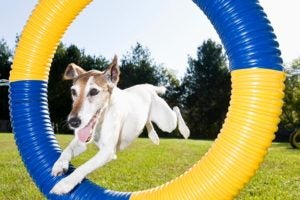Learning Objectives
After an introduction to energy terminology, students will complete research on energy and how it relates to various dog breeds and the dog sports that they can compete in. Students will create a bar graph in groups and present to the class on their findings.
Grade Levels
6-8
Next Generation Science Standards (National Science Teachers Association)
MS-PS3-1: Construct and interpret graphical displays of data to describe the relationships of kinetic energy to the mass of an object and to the speed of an object.
ELA/Literacy Standards
RST.6-8.7: Integrate quantitative or technical information expressed in words in a text with a version of that information expressed visually (e.g., in a flowchart, diagram, model, graph, or table).
Materials Needed
Access to computers/tablets/personal cellular devices with internet capabilities
Canine Sports and Energy Packet (one per student): Canine Sports and Energy Packet
Projector
Calculators (one per student)
Graph Paper
Pencils/Colored Pencils
Lesson
Prior Learning
- Before beginning the lesson, introduce students to the following vocabulary terms: energy, mass, velocity (speed), joules, potential energy, and kinetic energy. Have students define the terms independently and provide examples in their packets. Discuss as a class and share findings.
- Review bar graphs and how to label them appropriately.
Introduction
- Explain to students that they will be learning about different canine sports and how they relate to the science of energy, specifically potential and kinetic energy.
Guided Instruction
- Using a projector to ensure all students can view, go HERE and click on the Sports & Events drop-down arrow. Click on “Intro to Dog Sports.” Explain that there are many different canine sports that people participate in depending on their dog’s appearance, health, and temperament.
- Discuss the different sports to choose from: Obedience, Rally, Tracking, Herding, Agility, Diving, Lure Coursing, etc. The teacher can view different categories under Sports & Events. Use this opportunity to show students how to search for dog breeds under the drop-down “Breeds A-Z.”
- Show students an AKC video about an Agility Course Test (ACT) by going HERE.
- Discuss the canine sports in relation to potential and kinetic energy. Have students write the following in their packets and then illustrate it with a drawing: Prior to engaging in their sports and while sitting still, the dogs are storing potential energy, or energy waiting to be used. When potential energy is used, it is converted into kinetic energy, or the energy of motion, when the dog is moving.
- Discuss how kinetic energy is determined by the mass of the moving object and its velocity or speed and is expressed in “joules”. Have students write the following equation in their packets: Kinetic Energy= 1/2 m*v^2. Students will fill in the corresponding blanks of what each letter stands for. Relate this to different dog breeds and how their masses and speeds may differ and therefore will alter their kinetic energy.
- With students, practice solving Kinetic Energy Problems together and independently in their packets in preparation for their group project and presentations.
Group Project (Students will work in partners)
- Utilizing the AKC website and their devices, students are instructed to choose five different dog breeds from the AKC dog breeds web page to compete in one specific dog sport of their choice and write their choices in their packets.
- The students must explain why they chose that specific breed to participate in that sport in their packets. They must also locate approximate masses for each of their dogs on the breed specific page (they will have to convert pounds to kilograms).
- In addition, students will solve equations in their packets to determine the Kinetic Energy for each breed participating using an average velocity of 0.5 m/s (Note to teacher to discuss with students: This is not an accurate velocity but used for practice. The velocity will differ depending on the sport and the dog breed).
- After solving their equations, groups will create a bar graph to visually represent the Kinetic Energy in joules for each of their dog breeds. Instruct each group to appropriately label their graphs on each axis and to title their graph.
- Students will answer follow-up questions in their packets and prepare to present their findings to their classmates.
Review and Closing
- Students will present their findings to the class. Teachers can use this as an opportunity to review dog breeds, canine sports, and the topic of energy.
References
Agility Course Test video. (n.d.). Retrieved from https://www.akc.org/video-library/?video=THK6YhBq.
Dog Breeds. (n.d.). Retrieved from https://www.akc.org/dog-breeds/.
Intro to Dog Sports. (n.d.) Retrieved from https://www.akc.org/expert-advice/sports/get-started-in-dog-sports-and-events/.


